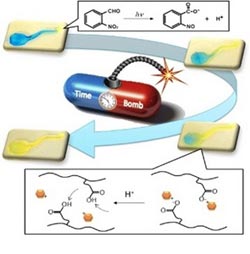Targeting drugs with hydrogels

A smart hydrogel-based time bomb triggers drug release mediated by pH-jump reaction<br><br>Copyright : Science and Technology of Advanced Materials<br>
Better control over the delivery of drugs to specific sites in the body at specific times would reduce unwanted side effects and improve medical treatment dramatically. ‘Smart’ polymers are promising materials for controlling drug delivery, since they change their properties in response to specific stimuli.
However, they usually require continuous stimulation to maintain these changes. Now, researchers led by Takao Aoyagi at the MANA, National Institute for Materials Science, Japan, have developed an approach that could allow more subtle control and timing of drug delivery.
The new technique uses hydrogels, which are a type of ‘smart’ polymer made of water-soluble long-chain molecules. The team first showed that they could control the acidity inside a hydrogel by loading it with a compound called o-NBA. This releases protons, which increases acidity, when irradiated with UV light. When o-NBA-loaded hydrogel was irradiated, acidity increased inside; if only part of the gel was irradiated, acidity throughout increased gradually as protons diffused.
Aoyagi and his colleagues then loaded hydrogel with o-NBA and L-DOPA, a precursor of the brain chemical dopamine that is used in the treatment of Parkinson’s disease. The change of acidity in the gel upon UV irradiation caused L-DOPA to be released because the acidity disrupted the interaction of L-DOPA with the molecules in the gel.
Irradiation with UV not only enhanced overall L-DOPA release from the hydrogel, but also caused an extra ‘explosive’ release five hours after irradiation. This allowed the drug release to be timed, as well as triggered, in a controlled way.
Being able to control the release of drugs from hydrogels by triggering a change in acidity could help to design programmable drug delivery techniques that offer improved targeting of treatment.
Contact
Publisher
Mikiko Tanifuji
National Institute for Materials Science
Tsukuba, Japan
Tel. +81-(0)29-859-2494
Email: stam_office@nims.go.jp
Journal information
Prapatsorn Techawanitchai, Naokazu Idota, Koichiro Uto, Mitsuhiro Ebarab and Takao Aoyagi (2012) A smart hydrogel-based time bomb triggers drug release mediated by pH-jump reaction. Science and Technology of Advanced Materials Vol. 13 (2012) p. 064202.
Media Contact
All latest news from the category: Materials Sciences
Materials management deals with the research, development, manufacturing and processing of raw and industrial materials. Key aspects here are biological and medical issues, which play an increasingly important role in this field.
innovations-report offers in-depth articles related to the development and application of materials and the structure and properties of new materials.
Newest articles

Bringing bio-inspired robots to life
Nebraska researcher Eric Markvicka gets NSF CAREER Award to pursue manufacture of novel materials for soft robotics and stretchable electronics. Engineers are increasingly eager to develop robots that mimic the…

Bella moths use poison to attract mates
Scientists are closer to finding out how. Pyrrolizidine alkaloids are as bitter and toxic as they are hard to pronounce. They’re produced by several different types of plants and are…

AI tool creates ‘synthetic’ images of cells
…for enhanced microscopy analysis. Observing individual cells through microscopes can reveal a range of important cell biological phenomena that frequently play a role in human diseases, but the process of…





















